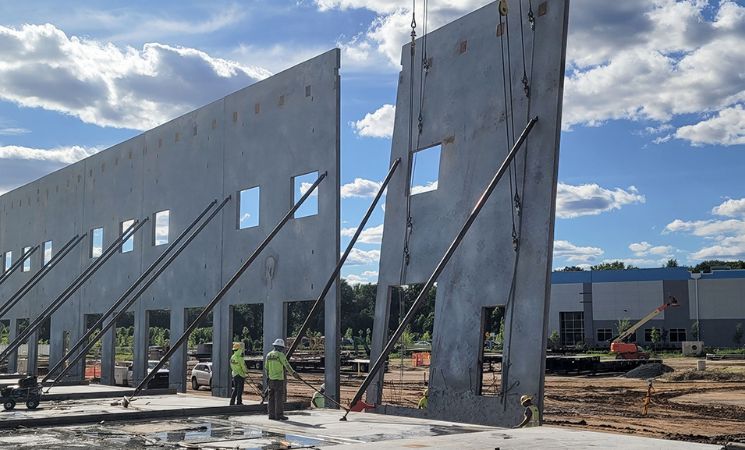The construction industry continually evolves, adapting innovative methods that provide not only speed and efficiency but also sustainability and durability. Among these innovative approaches, tilt up construction has emerged as a frontrunner, revolutionising how structures are built. This article aims to explore the rise of tilt-up construction, its benefits, and why it’s becoming a preferred method for builders and developers worldwide.
Understanding Tilt-Up Construction
Tilt-up construction is a building technique where large concrete panels are poured directly at the job site in large slabs, known as “tilt-up panels” or “tilt-wall panels”. Once cured, these panels are raised into position with cranes to form the walls of a building. This method is often chosen for its speed of construction and economic benefits.
The Early Adoption and Evolution
The origins of tilt-up construction date back to the early 20th century, gaining popularity in the post-World War II era due to the shortage of skilled labour and the need for cost-effective construction methods. Since its inception, tilt-up has evolved with the advent of modern technology and engineering practices, making it a staple in commercial and industrial building projects.
Advantages of Tilt-Up Construction
Choosing tilt-up construction comes with a myriad of advantages. Firstly, it is cost-effective as it requires fewer workers and can be completed faster than traditional construction methods. The use of concrete provides excellent durability and fire resistance, contributing to the longevity and safety of the structure.
Reduced Time Frames
Time efficiency is one of the most significant benefits of tilt-up construction. The ability to create the building’s panels on-site and in parallel with other foundation work can considerably reduce the overall construction schedule, allowing projects to be completed in a shorter time frame.
Architectural Versatility
Contrary to some misconceptions, tilt-up construction allows for considerable architectural flexibility. Panels can be crafted with an array of finishes, textures, and even incorporated into various architectural styles, making it an adaptable solution for many design requirements.
Environmental Considerations
Environmentally, tilt-up construction has a sustainable edge. The process produces less waste and the thermal mass of the concrete provides energy efficiency for the buildings, reducing heating and cooling costs.
The Financial Implications
The economic impact of adopting tilt-up construction extends beyond the immediate cost-savings in labour and time. The longevity and energy efficiency mentioned earlier contribute to lower lifecycle costs of buildings, resulting in long-term savings for property owners.
Innovation in Construction
Industry leaders have recognised tilt-up as an innovative method that leverages technology for precision and efficiency. Tilt-up panels can be pre-designed using sophisticated software, ensuring accuracy and integrating seamlessly with other construction elements. The method exemplifies modern innovation in construction, offering a forward-thinking approach to building.
Tilt-Up Construction’s Role in the Modern Era
The modern era of construction demands speed, economy, and quality, all of which are encapsulated in the tilt-up approach. It is not just a method but a testament to the industry’s capacity to adapt and improve upon traditional construction techniques.
A Global Perspective
Globally, tilt-up construction is gaining momentum. It is not constrained by geographical boundaries and can be adapted to various climates and locales, proving its versatility and international appeal.
Challenges and Solutions
Despite its many benefits, tilt-up construction faces challenges, particularly in regions that are unfamiliar with the process. There may be a learning curve and a necessity for skilled professionals to oversee the project. However, the construction industry has demonstrated a willingness to meet such challenges by investing in training and development for workers.
Case Studies and Successful Implementations
Several high-profile projects have employed tilt-up construction, serving as case studies for its efficacy. These include large-scale warehouses, office buildings, schools, and even residential properties. Through these projects, the potential for tilt-up to meet diverse construction needs is continually proven.
Project Analysis
Detailed analyses of these projects often reveal significant reductions in construction time and costs, bolstered safety records, and positive environmental impacts. These analyses have become valuable resources for industry professionals considering tilt-up for future projects.
Looking Toward the Future
The future of construction includes tilt-up as a key player. As the industry prioritises efficiency and sustainability, the adoption of tilt-up is likely to increase. This growth will be supported by advances in technology and materials science, driving further innovation within the method.
Conclusion: Embracing Change and Innovation
The rise of tilt-up construction represents a modern building revolution that synthesises speed, cost-effectiveness, and sustainability. With its increasing adoption worldwide, it’s evident that the construction industry is embracing new techniques that pave the way for better, smarter buildings. As we move further into the 21st century, tilt-up construction stands as a testament to human ingenuity and the ever-evolving nature of architectural achievement.












